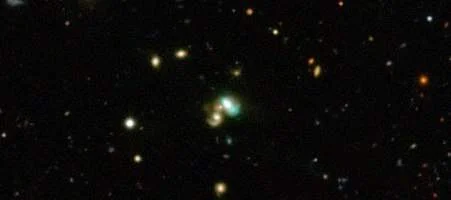Astronomers have classified a new type of galaxy after they noticed that it glowed an unusually bright green.

Mischa Schirmer an astronomer at the Gemini Observatory, was struck by the object’s strange colour while scanning images of the distant universe from the Canada-France-Hawaii Telescope. He investigated it further using the European Southern Observatory’s telescope in Chile.
Known as ‘J2240’, the object, is a new type of glowing galaxy that is thought to be powered by a black hole at its centre, which used to be very active but is now turning off.
“Ten minutes after the data were taken in Chile, I had them on my computer in Germany, says Shirmer.
I soon refocused my research activities entirely as it became apparent that I had come across something really new.”
After looking through nearly a billion other listed galaxies, Shirmer and his team found several other examples like J2240 that appeared to share the same green-glowing properties. They nicknamed them ‘green bean’ due to their colour and the fact that they superficially look like a larger version of another type of galaxy: the ‘green pea’.
Many galaxies are powered by large black holes at their centre which give off powerful radiation that causes the giant dust clouds surrounding them to glow. These glowing regions are usually small, around 10% of the galaxy’s size but in the case of green bean galaxies, these glowing regions are the size of the entire galaxy.
“These glowing regions are fantastic probes to try to understand the physics of galaxies — it’s like sticking a medical thermometer into a galaxy far, far away,” says Schirmer.
Usually, these regions are neither very large nor very bright, and can only be seen well in nearby galaxies. However, in these newly discovered galaxies they are so huge and bright that they can be observed in great detail, despite their large distances.”
The team believe that green bean galaxies are going through a particular phase in the lifetime of a galaxy; they think the green glow may be an echo of the galaxy’s past when the black hole used to be more active. They also hope that the green beans may help to answer the question of why young galaxies are less active now than they used to be in the early Universe.
Green bean galaxies are so rare that they are estimated to only be one in a cube for every 1.3 billion light-years across. The team’s findings are published in a paper in The Astrophysical Journal.






